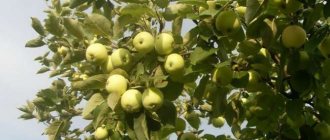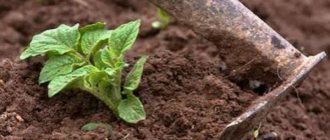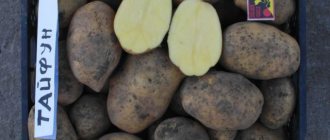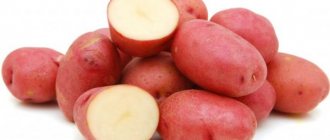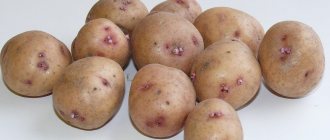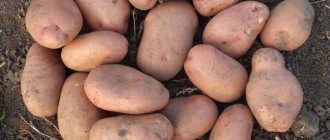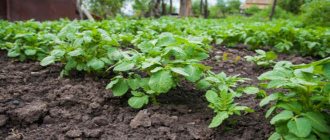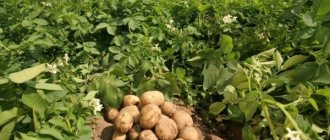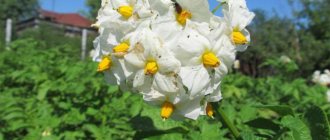Description of the variety
Table potatoes of the Nevsky variety (popularly called Sineglazka) are varieties of medium-early ripening. Technical ripeness occurs 75-90 days after emergence. The plant develops quickly, tubers form together.
The bushes are distinguished by medium height (no higher than 55-60 cm), semi-spreading erect stems. Although the leaves are small, there are a lot of them on the bushes. The leaf blades are wide, light green in color. The surface of the leaf is glossy, with slight waviness at the edges.
Thanks to the large number of leaves with a glossy surface, the sun's rays are reflected, and moisture evaporates from the soil more slowly. In drought and extreme heat, the leaves curl and resemble tubes. This also saves the bushes from evaporation and burns. This feature of the Nevsky potato makes the plant drought-resistant.
Important! The attacks of the Colorado potato beetle are not harmful to plants, as they are able to quickly restore damaged green mass.
Flowering is short but abundant. The buds are lush, with white corollas. Few berries (bollards) are formed.
In each hole, up to 15 round or oval tubers are formed, weighing 90-130 g. There are specimens weighing 200 g. The peel is beige, with pink-purple eyes located on it. According to the description, the Nevsky potato variety (as seen in the photo) has white flesh. Potatoes are dense, there are no voids inside them.
Tubers with thin and smooth skins are good to wash and peel. Each tuber contains only 12% starch. That is why the Nevsky variety is considered a dietary product.
Important! The yield of marketable potatoes is about 95%. The variety is popular not only among private owners, but also among serious agricultural producers.
Table: enemies and diseases of Nevsky
To protect potato plantings from damage by diseases and harmful insects, you need to know about methods of control and prevention against damage.
| Name | What amazes | Fighting methods | Preventive actions |
| Nematode | A small worm attacks the rhizomes and roots of potatoes | The pest is resistant to most chemical and biological agents. Affected bushes are removed from the beds and destroyed. | The beds are watered with hot water, and marigolds and oats are planted in the aisle. |
| Medvedka | A large representative of pests, it attacks root crops and is capable of destroying crops in a short time. | Insecticides and special traps are used for control. | Digging up the area, destroying the nests created by mole crickets. |
| Wireworm | The yellow worm damages root crops. | As protection against pests, when planting, pour mustard powder into the holes or pour out a solution of manganese. | The beds are sprinkled with wood ash, and weeds are carefully removed. |
| Late blight | It affects the above-ground part of the plant, as a result of which the bushes dry out and die. | The spread of the lesion is stopped with fungicide-based preparations. | To avoid damage, plants are treated with a solution of copper sulfate. |
| Root rot | It affects the green part of plants, as a result the bushes die. | At an early stage of infection, diseased plants are dug up and destroyed. | To prevent damage, timely care of plants and beds is carried out. |
| Colorado beetle | Affects the green part of plants | Insecticides are used for control | Inspection of beds and manual collection of pests. |
Harvest and storage
The first sign of ripening of root crops is yellowing of the tops. Harvesting work depends on the weather conditions of the growing region. In the middle zone, potatoes of the Nevsky variety are fully ripened by mid-August.
A dry day is chosen for harvesting. Root crops dug out of the ground are cleared of soil, dried and placed in boxes or bags for long-term storage.
Under properly created storage conditions, the vegetable crop perfectly retains its commercial and taste properties until spring.
Taste qualities of Nevsky potatoes
When the potato variety was included in the State Register, the description stated that the tubers tasted good. Judging by the reviews, consumers have differing opinions on this issue. Some people believe that the tubers are not suitable for culinary processing, and that the purpose of the variety is fodder.
Another group of consumers confidently notes the excellent taste when preparing soup, salad, potato pancakes, purees and other dishes. When cooked, the root vegetable does not become colored, does not lose its shape, and, most importantly, does not darken and remains white.
Of course, the Nevsky variety is not suitable for lovers of crumbly potatoes, because it contains little starch.
Attention! The taste of potatoes, according to reviews from gardeners, may vary due to the climatic characteristics of the region.
History of origin of the variety
Potato Nevsky is the fruit of the creative work of a team of employees of the North-Western Research Institute of Agriculture, now the Leningrad Research Institute of the Russian Academy of Agricultural Sciences. The initial varieties were Candidate and Veselovskaya. Since 1982, Nevsky has been included in the Russian State Register of breeding achievements approved for use. Let us note that this is the only one of the 426 potato varieties registered today that is approved for cultivation in all regions of the country. This indicates its unpretentiousness to soil and climatic conditions.
Nevsky is the only variety recommended for cultivation in all regions of the country
Pros and cons of the variety
Despite the fact that when creating varieties, they focus on the best qualities of the plant, in addition to their advantages, they also have disadvantages. They are reflected in the table.
| Advantages | Flaws |
| High and stable yield | Potatoes sprout early if storage rules are not followed |
| The variety is resistant to moisture and drought | Some culinary restrictions |
| Excellent presentation and transportability | Moderate susceptibility to late blight |
| After mechanical damage, the peel quickly tightens | |
| Not affected by many viral and fungal diseases characteristic of the crop |
Advantages and disadvantages of the variety
Breeders are trying to assign the best characteristics of the parent forms to the new variety. However, the output always turns out to be new varieties that have advantages and disadvantages. This is a normal result; it is important that there are many advantages and few disadvantages.
| pros | Minuses |
|
|
Planting and caring for Nevsky potatoes
When planting potatoes of the Nevsky variety, it is necessary to apply agrotechnical standards. You need to start with selecting and preparing a site and planting material. The planting pattern is the same as for other potato varieties.
Selection and preparation of a landing site
Nevsky potato variety is a heat-loving crop. Therefore, a well-lit area is chosen for planting. Work should be planned taking into account the climatic conditions of the region. The soil should warm up well at a depth of 25 cm to 14 degrees.
In the southern regions, tubers of the Nevsky variety are planted in the last ten days of April. In the risky farming zone - after the threat of frost has disappeared, at the end of May or beginning of June.
Comment! Potatoes of any variety planted in cold soil are more often affected by late blight.
Potatoes love loose, air- and water-permeable soil. It should have enough nutrients. If the soil is depleted, it needs to be filled with compost and humus. It is not advisable to add fresh manure to the crop, since it will cause a lot of weeds, pests and diseases on the site.
Warning! In low areas where water stagnates after rains, Nevsky potatoes are not planted. The plant survives a lack of water more easily than an excess.
Preparation of planting material
Before planting, Nevsky seed potatoes need to be specially prepared:
- germinate;
- specially processed.
Germination begins a month before planting:
- Sort through the planting material, discard tubers with diseases and damage.
- Calibrate the seeds by weight. It is best to choose tubers weighing 50-80 g, no more than a chicken egg.
- Lay the potatoes out in the sun in a warm room, in 2 layers at a temperature of +15 degrees.
- When the sprouts grow to 1 cm, the germination temperature is reduced to +12 degrees.
Immediately before planting, seed potato tubers need to be treated:
- To accelerate growth, use the drug “Poteitin” or “Mikom”.
- To prevent fungal diseases, place the tubers in a pink solution of potassium permanganate or boric acid.
- To repel pests you need to take “Cruiser”, “Maxim” or “Aktofit”.
Attention! The Nevsky variety has weak sprouts, so the tubers must be handled carefully.
Landing rules
Tubers are planted in rows located at the distance of an adult man's step - this is approximately 55 cm. Potatoes are laid out sprouts up every 40 cm to a depth of 12-20 cm, depending on the composition of the soil. A layer of earth of at least 5 cm is poured on top.
Many gardeners use the Nevsky variety for planting potatoes:
- square-cluster method;
- under agrofibre;
- under straw;
- into the ridges.
You can add wood ash, bone meal, or throw in a few peas into the hole.
Attention! Wood ash can replace some mineral supplements, as it contains up to 12% potassium, 6% phosphorus and 40% calcium.
If gardeners prefer mineral fertilizers, then you can use potassium sulfate, potassium magnesium, superphosphate, taking into account the instructions.
Further care
Shoots, as a rule, appear after 7-10 days. Caring for Nevsky potato plantings is not difficult, especially if you have experience. After all, the events are exactly the same for all varieties of crops. Weeds need to be removed as they grow, and hilled up high enough so that additional stolons appear on which ovaries form.
Work on the potato field during different periods is shown in the table.
| Period | Watering | Loosening, hilling | Feeding |
| Before budding | After 7-12 days in the absence of precipitation per square meter. m requires up to 10 liters of water | First, the soil is loosened at least 2 times. Then they hill up when the bush grows to 12 cm, repeat hilling after 21 days | Spraying plantings in the evening in dry weather with an ash solution 14 days after germination Watering at the root with fermented grass |
| Flowering period | Per sq. m requires 20 liters of water in 1-2 weeks After flowering is completed, watering is reduced, and 2-3 weeks before harvesting, it should generally be stopped. | When the bushes grow to 20 cm, the row spacing is mulched to prevent the growth of weeds | Watering with a mixture of ash (3 tbsp.) and potassium sulfate (1 tbsp.) per 10 liters of water When all the plants bloom, feed the Nevsky potatoes with mullein |
Advice! Potatoes need to be hilled in moist soil. If there is no rain, then the area is watered a day before work.
Harvest and storage
This mid-early variety is ready for harvesting 75–90 days after germination. Potatoes must be harvested in dry, warm weather; after digging, they are laid out in the open air to dry. Sick tubers are destroyed, damaged ones are separated from the main mass. After drying, the potatoes are placed in temporary storage indoors for a period of 2–3 weeks. During this time, the skin becomes rough and mechanical damage occurs.
The permanent storage room for potatoes must have ventilation and an air temperature of 3–5 °C. Separately, tubers selected for seeds are stored in it. It’s good if the potatoes are stored not in bulk, but in wooden boxes that are not solid. Their bottoms should be raised above the floor.
Potatoes intended for food and seed potatoes are stored separately
As noted above, the main purpose of Nevsky in cooking is to use it in salads and for preparing first courses - it holds its shape well during heat treatment. However, many believe that it can be successfully boiled and fried.
You can treat yourself to Nevsky young potatoes already in July
Video: Nevsky harvest from 10 bushes
Diseases and pests
Seed potatoes of the Nevsky variety, according to reviews from those who have been dealing with them for decades, are rarely affected by:
- potato cancer (D1);
- viruses (Y, A, X);
- wet rot;
- black leg;
- rhizoctoniasis;
- common scab.
But the plant must be protected from golden nematode and late blight.
| Diseases, pests | Signs | Preventive measures | How to fight |
| Late blight | Rapid spread of brown spots on leaves and stems. The growth of bushes slows down, which negatively affects productivity | Use healthy tubers for planting. Change the potato field every 3-4 years | Spraying bushes with Bordeaux mixture or copper sulfate |
| Nematode | Small worms that live on roots. The cyst overwinters in tubers and soil. Infected potatoes quickly rot during storage. | · inspection of tubers before planting; · use of crop rotation; · planting next to dill and marigolds; · sowing green manure; · destruction of infected tops and tubers | Treatment with Nematorin in accordance with the instructions |
| Colorado beetle | Beetle larvae are dangerous for plants | · loosen and mulch the soil; · plant plants that the beetle does not like: sage, tansy, mint, garlic and other strong-smelling herbs; dig up the soil in the fall | · remove larvae manually; · treat tubers with special preparations before planting; · spray the plantings with a solution (per 10 liters of water): 500 g of 9% vinegar and 100 g of baking soda; · there is another option: dissolve laundry soap, add 100 g of red pepper, mix and spray the plantings |
| Wireworm | Larva of a click beetle. Makes many moves in potatoes | · dig up the soil in the fall; · destroy weeds; · apply crop rotation; · sow green manure after harvesting or plant peas, beans, beans next to potatoes | If there are a large number of wireworms, the soil is treated with Aktara and Aktellin. Although the death of beneficial microorganisms living in the soil is possible |
Landing Features
You can plant Nevsky no earlier than May, since the soil must warm up well before planting. The place for potatoes is chosen in a lighted area; the predecessors can be cucumbers and tomatoes. Gardeners advise that to prevent potatoes from degenerating over the years, the planting site is changed every 4-7 years. You can share the tubers with your neighbors or simply grow a different variety of vegetable one year.
Before planting, the soil is dug up and horse manure is added to it. About kg of fertilizer should be consumed per meter. Nevsky shows especially good yields on sandy soils; on clay soils it grows for a long time. If the soil on the site is heavy, mix it with river sand in advance to increase porosity.
Tubers are germinated for 2 weeks before planting. When the shoots are stronger and their length is at least 1 cm, the tubers can be planted in the ground. The depth of the hole should be about 20 cm, since the variety is quite tall. There needs to be at least 50 cm of space between the holes, otherwise the tops will get in the way.
Storage
The dug up potatoes are thoroughly dried before storing. Then they sort it out, since it is advisable to put tubers of different sizes in separate boxes.
The keeping quality of the Nevsky variety is high; up to 96% of the harvest is preserved by spring. Potatoes do not wrinkle, do not rot, and do not germinate prematurely if the temperature conditions in storage are maintained. With the onset of spring it begins to sprout.
Nevsky seed potatoes, according to the description, are stored well if they are first dried and heated in direct sunlight.
Yield varieties: https://www.youtube.com/watch?v=ymDGm4YPmO0
Care
Hilling
After planting the seeds, the soil is loosened and weeds are removed. In a month, the plants will grow to 15 centimeters, after which you can hill up and form mounds next to the bushes. Repeated hilling is required when the bushes grow to 30 centimeters. These events are held in cloudy weather or in the evening.
Watering
It is advisable to use a watering can for watering, as strong pressure from the hose erodes the soil. Each bush requires approximately 3 liters of water.
Feeding
Fertilizer is applied three times.
- Before flowering, use a mullein solution: 500 milliliters per 10 liters of water with the addition of a tablespoon of urea.
- At the stage of bud emergence, the following fertilizing is used: 10 liters of water, 3 tablespoons of ash, a tablespoon of potassium sulfate.
- When flowering, use 10 liters of water, a glass of mullein and 2 tablespoons of superphosphate.
Such fertilizing guarantees improved properties of potatoes.
Reviews about the Nevsky potato variety
Vyacheslav Sergeevich Tsyganov, 58 years old, Perm region.
I have been planting Sineglazka potatoes (Nevsky variety) for almost 20 years. I give him several beds in the potato field. I sell part of the harvest and put the remaining tubers into storage. The description says that seed potatoes need to be germinated. I skip this procedure, since the sprouts easily come off, which affects the number of shoots and the final result. A week before planting, I take out the potatoes and warm them in direct sunlight. Germination is always excellent.
Mashkova Liza Yurievna, 49 years old, Moscow region.
Getting an early potato harvest is the task of summer residents. Somehow neighbors advised me to plant a new variety, Nevsky. In the first year I received an excellent harvest and left the tubers for seeds. I've been planting my own potatoes for several years now. It has a good taste, the tubers are not watery and peel well. The bushes are almost not affected by diseases and pests. Before planting, I fertilize the soil with rotted manure and be sure to add wood ash. I basically don’t use chemicals. I start digging up Nevsky potatoes in the second half of July. I advise you to plant at least a bucket for variety.
Landing
Selecting a location
Potatoes turn out to be practically unpretentious to growing conditions. Despite this, the right choice of location still contributes to obtaining a large amount of harvest.
- It is recommended to choose sunny, open areas. Any permanent shadow from trees or buildings is undesirable.
- Heavy clay soil can be used. However, it is advisable to give preference to sandy loam and light loamy soils, which are the most fertile.
- To obtain the Nevsky variety, it is not important to observe correct crop rotation. Regular use of organic fertilizers allows you to grow potatoes for 2-3 years in the same place.
- When changing the location of a site, it is advisable to take into account the influence of previous crops. Legumes, corn, cabbage, carrots and greens are ideal precursors.
- Plowing is preferably carried out in spring or autumn; adding mineral fertilizers is recommended in autumn.
- Potatoes should not be planted in cold soil. For this reason, it is possible to remove snow from the site at the very beginning of spring and speed up the warming of the soil.
A correctly selected site will contribute to the proper development of the potato root system, so you can count on getting a large and good harvest.
Soil preparation
Proper soil preparation when growing the Nevsky variety is mandatory. It is advisable to prepare the soil immediately after harvesting, and at this time potato tops and weeds are removed. It is expected to dig up the soil and use 2 cups of lime per square meter.
Feeding is also required in spring. It is planned to use a glass of ash, a tablespoon of superphosphate and a teaspoon of potassium sulfate. This solution will be enough to treat a square meter.
In addition, fertilizers are applied taking into account the type of soil:
- clayey – humus or peat;
- peat - compost, sand or humus;
- sandy - clay soil or peat.
Additional fertilizers are applied according to the wind for each square meter.
Tuber preparation
In the fall, tubers from productive and healthy bushes are selected for seeds and further cultivation. The optimal weight is 60-80 grams. In this case, the potatoes must be free of damage, signs of disease or parasite damage. Tubers that will later be used for growing potatoes cannot be cut and they must have strong sprouts up to 12 millimeters in length.
In the spring, you get or buy seeds a couple of weeks before planting. It is mandatory to treat the seed material in a solution of potassium permanganate, and the duration of soaking should not exceed 3 minutes.
Before planting in open ground, boxes with potato seeds are placed in a room that is heated to 15-18 degrees.
Landing
Potatoes are planted in holes, grooves, and ridges. The distance in the row should be 35 centimeters. It is advisable to place the beds at a distance of 60 centimeters. Potatoes are planted only in warm soil, since Neva potatoes are susceptible to spring frosts.
A handful of humus, 2 tablespoons, and crushed eggshells are added to the hole. This mixture promotes successful potato growth.
Harvesting
The Nevsky potato harvest begins in mid-August, when the tops die off. Of course, you can try fresh potatoes in the third ten days of July. To dig up ripe tubers, choose non-rainy weather. Potatoes cannot be immediately put into bags; they must first be ventilated by spreading them in one layer on a dry, flat surface. During harvesting, it is better to sort the tubers immediately, simultaneously selecting those suitable for seeds and destroying the affected specimens. The root crop is placed in boxes and placed for storage in a dark basement with a temperature no higher than 8–10 °C. Nevsky has excellent keeping quality.
The potato harvest of the Nevsky variety pleases with its abundance
Features of growing the Nevsky variety
Nevsky, like any other potato variety, is traditionally grown by planting seed tubers in the ground in late spring. Seeds can be purchased at any specialty store, ordered by mail, or selected independently from a previous harvest.
Seed preparation
The ideal mother material would be tubers the size of a chicken egg, without mechanical or other damage, without signs of disease and parasites. It is important not to miss the moment of their germination and, before this process, have time to treat the seed tubers with a solution of potassium permanganate (10 crystals per 1 liter), dry thoroughly and place them in boxes in one layer. The seed container should be placed in the brightest place at a temperature of about 8–10°C a month before planting in order for sprouts to appear. Nevsky is distinguished by the fact that it germinates amicably and quickly.
It is important to remember that the Nevsky potato variety is not grown by cutting large tubers into pieces.
Nevsky seed tubers undergo careful selection
Soil preparation
It is best to prepare the land for planting potatoes in the fall, processing and applying fertilizers before winter for optimal distribution, destroying weeds and pests.
Selecting a location
It should be remembered that Nevsky loves good lighting. Therefore, it is better to forget about darkened areas and areas in the shade of houses and trees if the goal is a good, rich harvest. Also not suitable is the land where nightshades lived last year: potatoes, tomatoes, peppers, eggplants; in this case it is better to wait 2–3 years. But after cabbage, cucumbers, and oats, you can safely plant potatoes. Nevsky prefers light loams and sandy loam soils. Ridges near groundwater flow and in lowlands will not be entirely successful.
Land cultivation and fertilization
It is recommended to prepare the soil in the autumn. It is necessary to carry out deep digging using a spade bayonet with the addition of fertilizers. It is very important to destroy weed roots and pest larvae as much as possible.
Organic fertilizers:
- One bucket of compost and rotted manure (humus) per 1 m2.
- If the soil is peaty, add a bucket of coarse sand and compost per 1 m2.
Under no circumstances should you use fresh manure as a fertilizer: it sharply reduces the taste of potatoes and contributes to the development of late blight.
Mineral fertilizing per 1 m2:
- Two tablespoons of nitrophoska.
- One glass of ash.
- One tablespoon of superphosphate.
There is no need to level or harrow the ridges after autumn digging.
In the spring, you should dig up the area again, distributing urea (mineral fertilizer) at the rate of one tablespoon per 1 m2.
If for some reason the beds are not prepared in the fall, deep digging with all the recommended fertilizing should be done in the spring, a week before planting the potatoes.
Deep digging of the soil is the key to a good potato harvest and excellent prevention against diseases and pests
Landing
It is better to plant prepared, sprouted potatoes. This is the key to quick germination and a good harvest. It must be remembered that the Nevsky variety loves warm soils, so it is recommended to plant it when all frosts have passed and the ground has warmed up to an average of 8 °C.
- Potato holes are dug at a distance of 50 cm from each other.
- The tubers are placed in the holes with the sprouts up, carefully, without damaging or breaking them.
- The planted potatoes are lightly sprinkled with soil on top.
- After planting, you need to fence the area with a rake.
Potatoes are planted in well-warmed soil.
Care during the growing season
Proper care of potatoes means the health of the root crop and a rich harvest in the future.
Loosening
Loosening is an important point in growing potatoes. This process improves the circulation of air and moisture. Loosening is carried out mainly after rains in order to prevent the formation of an earthen crust, using a rake, just a couple of centimeters deep.
Hilling
Hilling is a mandatory activity for caring for potatoes during the growing season; it involves forming a mound of earth around a potato bush using a hoe.
- The first hilling is carried out when the length of the stems reaches 10–14 cm. The earth is carefully raked to the bush using a hoe. All this makes it possible to form young lateral roots and protects against late blight and root rot of the tops.
- The second hilling is carried out approximately 20 days after the first for the same purpose.
Potato hilling is carried out twice during the growing season.
Weeding
Weeding potatoes is essential. The presence of weeds in the beds should not be allowed. Grass is an excellent habitat for various pests and contributes to the rapid development of dangerous diseases.
Watering
Nevsky is an extremely drought-resistant variety due to the peculiarities of the structure and arrangement of the leaves. But there is a limit to everything, and lack of watering, one way or another, will affect the quality and quantity of the harvest. The soil should not be allowed to dry out and in the absence of rain for a long time, water regularly.
Top dressing
During the entire period of growing season and potato development, fertilizers are applied three times:
- During the period of active growth of stems to support their good development. A tablespoon of urea should be dissolved in 10 liters of water at room temperature. Consumption - 0.5 l per bush.
- During budding to stimulate flowering. For 10 liters of water, a glass of ash and a tablespoon of superphosphate. 0.5 liters for each bush.
- During flowering for active formation of tubers. For a ten-liter bucket of water, one tablespoon of superphosphate. 0.5 l per bush.
Video: tips for planting potatoes
Diseases and pests of Nevsky
If you do not start effective control of dangerous diseases and pests in time, you can lose more than half of the harvest. Nevsky is quite resistant to common potato diseases, but is practically powerless against pests.
Table: characteristic diseases
| Name | Description | Struggle | Prevention |
| Late blight of tops | Brown spots on leaves that dry out in the sun. Leaves and stems quickly dry out and die. On the back of the leaf there is a white coating - these are fungal spores. | There is practically no cure. We can only slow down the spread of this dangerous disease.
|
|
| Root rot | The leaves turn yellow, die, and the stems rot at the base. | Can't be treated |
|
Table: dangerous pests
| Name | Description | What damages | Struggle | Prevention |
| Wireworm | A hard yellow worm reaches a length of 3 cm. | Tubers |
|
|
| Medvedka | A large insect up to 7 cm long, gnawing mouthparts, very strong forelimbs with which the mole cricket breaks through passages. | Tubers |
| While digging the site, pay attention to the larvae and nests and destroy them immediately. |
| Colorado beetle | An insect about 1 cm in size with a bright color. Its wings have noticeable longitudinal stripes. The larvae are bright red. Eggs are laid on the underside of the leaf. | Leaves, stems |
| Daily inspection of potato plantings. |
| Harvest mouse | small rodent | Tubers |
| Deep digging of the soil. |
| Nematode | A small roundworm, barely visible to the eye, forms compactions on the roots and causes the death of the plant. At the same time, the bush lags behind in growth, the leaves turn yellow and curl. | Roots, tubers | Fighting nematodes is very difficult. Even the strongest chemicals do not help, but they are dangerous for humans and plants.
|
|
Photo gallery: dangerous diseases and pests of Nevsky
The nematode thrives in moist soils
Wireworm loves acidic soils
Field mouse - rodent, pest of garden crops
The mole cricket damages root crops by digging holes in the soil
The Colorado potato beetle is a dangerous pest that can destroy more than 70% of the crop over the summer
Root rot is an incurable disease
Late blight of potato tops occurs at high humidity and low temperatures
Preparing the site and tubers for planting
In the fall, the garden is dug up with a shovel or processed using a mechanized method, while compost and humus are added. The application of cow manure shows good results. In the spring, before planting potatoes, the ground is cleared of weeds. If necessary, plow the soil again and add phosphate mineral complexes.
Before planting, tubers are sorted, inspected, and germinated. A special feature of the preparation is the inadmissibility of dividing the potato into parts. Tubers of the Nevsky variety are planted only as a whole, even if they are large. During sorting, potatoes with signs of rot, mechanical and other damage are rejected. A tuber weighing 60-80 g with thick sprouts is considered suitable for planting.
Even before germination begins, it is recommended to disinfect the planting potatoes by dipping them in a solution of potassium permanganate for 3 minutes. Wet tubers are laid out in one layer to dry and germinated in a warm room for about 3 weeks. At the time of planting, the length of the sprouts should be within 3 cm.
Characteristics of the Nevsky variety and photos of tubers
The Nevsky potato was bred in 1976 at the North-Western Research Institute of Agriculture by crossing two domestic varieties - Veselovsky and Candidate. The efforts of the breeders were not in vain - the result of their labors quickly took a leading position among common potato varieties, which it has successfully held to this day.
This variety is one of the most popular in our country. Thanks to the combination of such important qualities for potatoes as excellent taste, record yield and the ability to withstand common diseases and unfavorable growing conditions, the Nevsky variety occupies approximately a quarter of the area allocated for planting potatoes in Russia.
Productivity, ripening time
This mid-early variety, which was originally zoned in Western and partly in Central Siberia, is today approved for cultivation in any region . Why is it so attractive to a whole army of potato growers with a huge selection of varietal potatoes? First of all, it is worth noting the excellent productivity of Nevsky (380-450 kg, and if all agrotechnical practices are followed - up to 500 kg per hundred square meters).
Its popularity is also supported by the overwhelming number of extremely positive reviews about the taste of this potato variety. Gardeners are also attracted by its undeniable resistance to potato troubles: rhizoctonia disease and potato cancer, the invasion of the Colorado potato beetle and nematode. In addition, Nevsky tolerates slight drops in daily temperature or prolonged drought well, and is liberal in planting in poor soils. This is not surprising: breeders create a zoned variety for specific local conditions (climate, soil composition, pests), as a result of which it is always more generous in yield and consistently good in keeping quality.
Potatoes of the Nevsky variety can produce the first tubers of commercial size 80–90 days after planting, and from the moment friendly shoots appear above the soil surface, you need to wait only 65–75 days and you can harvest.
Bushes and fruits of Nevsky
This potato bushes are compact, low or medium in height, mostly erect with highly branching stems. Thick, dark green, medium-sized leaves serve as an excellent background for inflorescences of lush snow-white flowers.
A characteristic feature of the variety is that at the beginning of the active activity of Colorado potato beetles, the potato foliage manages to partially restore its lost mass.
Potatoes grow both medium size (90–110 g each) and large (110–130 g). With correctly applied doses of fertilizers, rather massive specimens (up to 150 g) can predominate on light soils . The tubers are oval, flattened-round in shape with a blunt apex. The color of the peel varies from white to light yellow with a few small pink eyes. When cut, a dense pulp of soft cream or white color is revealed, which subsequently does not darken when preparing any dish.
Nevsky potato tubers have yellowish-white flesh
Nevsky potatoes have a good taste and ability to hold their shape (they do not crumble when cooked). As a feature, it can be noted that this variety is not recommended for use for frying, but rather for cooking.
Table: advantages and disadvantages of the Nevsky variety
| Advantages | Flaws |
| Zoned for the cold Siberian climate | When planting in unheated soil, there is a significant delay in germination |
| The ability of seedlings to tolerate short-term frosts in spring and dry periods in summer | Breaking off sprouts has an adverse effect on seedlings |
| The maximum possible percentage of safety during winter storage | Due to its early ripening period, it requires a cool place to store it during the warm summer and autumn months. |
| The taste is satisfactory and good | Many varieties surpass it in taste |
| Ideal for cooking | Not quite suitable for frying - crumbles and loses shape |
| Resistant to Colorado potato beetle | Not resistant to nematode |
